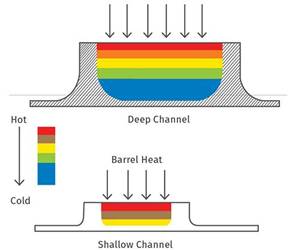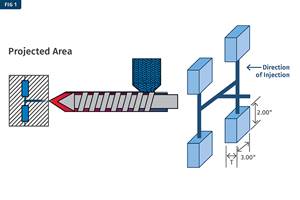Polymer Showdown — POM vs. POK — May the Best Material Win!
Third in a series, an expert from plastics engineering consultancy The Madison Group pits leading thermoplastics against each other to see how they differ in processing characteristics, chemical resistance, thermal and mechanical performance and more.
Unlike the materials we have compared in the prior installments in the series, polyacetal (POM) and polyketone (POK) are generally similar, albeit with some unique characteristics.
POM and POK are aliphatic semicrystalline engineering thermoplastics with a well-earned reputation for high performance in demanding applications. Both are valued for their strength, wear resistance and dimensional stability, but they differ significantly in structure and property profiles. While POM has been a mainstay in engineering design since the mid-20th century, POK represents a newer alternative with promising mechanical and chemical performance. This article provides a technical comparison of POM and POK, considering their chemical structures, mechanical and thermal performance, chemical resistance, processability and typical applications. The goal is to assist materials engineers and designers in understanding how these materials differ and where each excels.
Chemical Structure and Polymer Morphology
POM is available in two forms: homopolymer and copolymer. The homopolymer consists of repeating -CH2O- units, providing a high degree of crystallinity. In contrast, copolymer POM introduces a small percentage — typically 1-3% — of -CH2CH2O- units, which disrupts the molecular structure (Figure 1). The superior uniformity of the homopolymer structure results in a higher level of crystallinity and increased intermolecular hydrogen bonding, compared with the copolymer. This variation in molecular structure causes the homopolymer to have higher tensile strength and modulus across a temperature range, as well as better creep and fatigue resistance. The homopolymer has a higher melting point accompanied by a higher continuous use temperature. The copolymer, on the other hand, offers better chemical resistance to acids and bases as well as lower susceptibility to hydrolysis in hot water. The copolymer also offers superior oxidative resistance compared with the homopolymer.
FIG 1 — The chemical structure of polyacetal homopolymer and copolymer. Source (all images): The Madison Group
POK, specifically aliphatic polyketone, is a comparatively new material consisting of alternating ethylene and carbon monoxide (ketone carbonyl) units. Commercially available grades are terpolymers, which are achieved by incorporating a small amount of propylene functionality — generally 5-15% — into the polymer backbone during polymerization (Figure 2). This addition disrupts its molecular structure and lowers the crystallinity slightly, improving toughness and processability while decreasing the melting point. The presence of polar carbonyl groups provides strong intermolecular interactions, resulting in improved barrier properties and chemical resistance.
FIG 2 — Polyketone’s chemical structure.
While the composition of both POM and POK consists wholly of carbon, oxygen and hydrogen, the building blocks that form the polymers are significantly different. The oxygen in POM is incorporated into the backbone, forming an ether linkage between the carbon units. The oxygen in POK is present as a carbonyl structure, extending off the backbone, resulting in a backbone consisting exclusively of carbon units. This difference produces some unique variations in the performance properties of the two materials.
Thermal Properties
POM homopolymer exhibits a melting point around 175°C, while the copolymer variant melts at a slightly lower temperature — 165°C. The glass transition temperature (Tg) for polyacetal is also dependent on its structure, -85°C for the homopolymer and -60°C for the copolymer. Because the Tgs are so far below ambient temperature, the materials’ mechanical properties will decrease steadily and uniformly as the temperature increases from their Tg approaching their melting point.
While POM has been a mainstay in engineering design since the mid-20th century, POK represents a newer alternative with promising mechanical and chemical performance.
POK terpolymers have a melting range from 185 to 245°C, depending on propylene content— the higher the propylene content, the lower the melting point of the polymer. Thus, there is more variability in thermal properties as evidenced grade-to-grade compared with POM. POK has a significantly higher Tg than POM, nominally 11°C, which results in some variation in mechanical properties from just under ambient to slightly above. Grades of POK with lower propylene content offer the ability to maintain a usable modulus at temperatures where some other semicrystalline resins (including POM) soften considerably, this provides design flexibility for elevated temperature applications. This comparison is well illustrated through dynamic mechanical analysis (DMA) (Figure 3).
FIG 3 — Lower propylene content POK grades can maintain a usable modulus at temperatures where some semicrystalline resins (including POM) soften.
Because of their structures, POK will have higher melting points than POM. However, POM will have a higher crystalline structure. This is demonstrated well through differential scanning calorimetry (DSC) (figure 4).
FIG 4 — Differential scanning calorimetry (DSC) shows the higher crystalline structure of POM.
Mechanical Properties
POM, particularly the homopolymer, is known for its high tensile strength and modulus, as well as its excellent fatigue and creep resistance. It is often selected for load-bearing components requiring minimal dimensional change over time.
Typically, POK terpolymers have lower modulus and tensile strength than POM but are much more ductile, with elongation at break values exceeding 150% (Figure 5). They offer excellent impact resistance and good fatigue performance. DMA testing reveals a crossover in modulus between POM and POK at around 125°C (Figure 3). Below this temperature, POM maintains higher stiffness; above it, POK retains better performance.
FIG 5 — Tensile testing shows that POK terpolymers have lower modulus and tensile strength than POM, but higher ductility with elongation at break values exceeding 150%.
Results from comparative creep testing demonstrated superior performance for POK. Creep testing under identical stress and temperature conditions, with 14 MPa applied stress at 23°C, showed that while polyketone terpolymer was anticipated to strain more initially, it had a longer predicted time to failure compared with polyacetal copolymer. The polyacetal was projected to crack at approximately 50,000 hours, while the polyketone exceeded 200,000 hours [Jansen, J. A. (2021). Comparative Creep Evaluation of Polyacetal and Polyketone Resins. In Proceedings of the ANTEC 2021 Conference. Society of Plastics Engineers.] (Figure 6). This supports POK’s suitability for long-term load-bearing applications. The performance delta is especially relevant in applications such as fasteners, clamps or clips, where dimensional stability under load over years of service is critical.
FIG 6 — POK demonstrated superior performance over POM in comparative creep testing.
POM and POK both offer favorable tribological properties, but they achieve their performance through different mechanisms. POM, particularly the homopolymer, is known for its low coefficient of friction and excellent wear characteristics. These qualities have led to its widespread use in bearings, gears and sliding components. Additive packages such as PTFE, silicone or glass fibers are sometimes incorporated to further reduce friction or enhance wear resistance.
POM materials are generally stable up to their melting point but require careful thermal management during processing to prevent degradation.
POK also exhibits strong tribological performance, with a naturally hard surface and excellent resistance to wear under dynamic loading. Although its coefficient of friction is somewhat higher than unmodified POM, POK materials tend to experience less wear and surface degradation over time. The presence of the polar ketone groups contributes to a durable, abrasion-resistant surface.
Chemical and Environmental Resistance
POM copolymers offer improved resistance to hydrolysis and oxidation compared to homopolymers. However, both are sensitive to strong acids and bases, and tend to degrade under prolonged UV exposure. Outdoor use generally requires stabilization packages or pigment systems such as carbon black to limit degradation.
POK demonstrates exceptional chemical resistance due to its carbon-only backbone and polar carbonyl groups. It resists attack from weak acids, bases, alcohols and hydrocarbons. Its hydrolysis resistance is superior to many other engineering polymers, including POM. POK also exhibits minimal property degradation even at saturation moisture levels (~2.2%). UV resistance remains a limitation; the ketone groups are susceptible to photodegradation, though carbon black additives can help mitigate this for short-term outdoor use. From a permeation standpoint, POK performs well as an oxygen barrier, rivaling poly(ethylene:vinyl alcohol) (EVOH) and Poly(vinylidene chloride) (PVDC) in multilayer packaging structures.
Processing and Fabrication
POM is well established in the injection molding industry, offering excellent flow, dimensional control and reproducibility. It can be machined and welded, with copolymers generally offering easier processing. POM also has low shrinkage and high moldability, making it a preferred material for precision components. POM materials are generally stable up to their melting point but require careful thermal management during processing to prevent degradation. Oxidation and chain scission can occur above 220°C without proper stabilization, making screw design and residence time important considerations.
POK’s sensitivity to crosslinking with certain additives means that contamination must be avoided.
POK is newer and requires careful attention during processing. Its sensitivity to crosslinking with certain additives means that contamination must be avoided. Molders must adhere closely to processing guidelines. Despite these concerns, POK is successfully processed by injection molding, extrusion, film and blow molding. Drying is typically not necessary for moisture control but may be used to enhance surface appearance.
Applications
POM is commonly used in precision parts requiring high stiffness, low friction and dimensional stability. Applications include gears, bearings, fuel system components, door lock mechanisms, window lift gears and automotive fasteners. Its low wear rate and resistance to fatigue make it suitable for repeated mechanical motion under moderate loads.
POK has gained traction in newer markets, including children’s toys, food-handling conveyors, EV battery housings (in glass-fiber-reinforced grades) and barrier films. Its unique balance of toughness, chemical resistance and wear properties make it an appealing alternative in applications where POM, nylon or polyester limitations are evident. In food-contact applications, POK benefits from global regulatory approvals, including those from the U.S. FDA, EU and NSF.
Conclusion
Both POM and POK bring compelling attributes to the table. POM remains a benchmark for high-modulus, fatigue-resistant, low-friction components, while POK delivers excellent ductility, creep resistance and chemical durability. POM’s well-established processing and dimensional stability give it an edge in precision components, while POK’s chemical resistance and hydrolytic stability broaden its applicability in challenging environments. The decision between the two should be driven by application-specific requirements, particularly those involving long-term stress, exposure to aggressive chemicals or the need for impact toughness. As with any engineering material, performance validation through testing remains essential.
About the author: Jeff Jansen is the engineering manager and a partner at The Madison Group. Jansen is a graduate of Carroll College and the Milwaukee School of Engineering. He is an expert in failure analysis, material identification and selection, as well as compatibility, aging and lifetime prediction studies for thermoplastic materials. Jansen has been solving polymer-related problems for over 30 years and has performed thousands of failure investigations. He was recently elected as a Fellow of the Society, by the Society of Plastics Engineers. Contact: 608-231-6714; jeff@madisongroup.com
Related Content
The Importance of Barrel Heat and Melt Temperature
Barrel temperature may impact melting in the case of very small extruders running very slowly. Otherwise, melting is mainly the result of shear heating of the polymer.
Read MoreThree Key Decisions for an Optimal Ejection System
When determining the best ejection option for a tool, molders must consider the ejector’s surface area, location and style.
Read MoreIs There a More Accurate Means to Calculate Tonnage?
Molders have long used the projected area of the parts and runner to guesstimate how much tonnage is required to mold a part without flash, but there’s a more precise methodology.
Read MoreHow to Select the Right Cooling Stack for Sheet
First, remember there is no universal cooling-roll stack. And be sure to take into account the specific heat of the polymer you are processing.
Read MoreRead Next
Polymer Showdown — PC/ABS vs. PC/PBT — May the Best Material Win
First in a series, experts from plastics engineering consultancy The Madison Group will pit leading thermoplastics against each other to see how they differ in processing characteristics, chemical resistance, thermal and mechanical performance, and more.
Read MoreTracing the History of Polymeric Materials: Acetal
The road from discovery in the lab to commercial viability can be long, and this was certainly the case for acetal polymers.
Read MorePolymer Showdown — PPO vs. PA66: May the Best Material Win
Second in a series, an expert from plastics engineering consultancy The Madison Group pits leading thermoplastics against each other to see how they differ in processing characteristics, chemical resistance, thermal and mechanical performance, and more.
Read More











